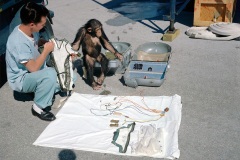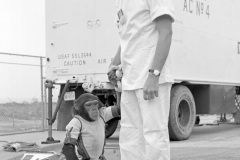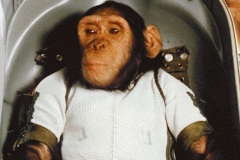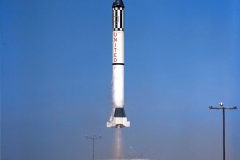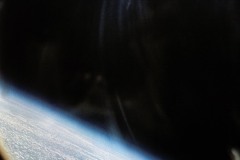Mercury-Redstone 2 (MR-2) was the dress rehearsal for the USA’s first manned space flight (MR-3). On board was the chimpanzee Ham.
With MR-2, the entire program of a ballistic space flight was to be carried out with an animal on board for the first time. A chimpanzee was choosen because these animals are most similar to humans in terms of body structure and reactions.
Six chimpanzees were trained for several weeks to press specific levers in dummy spaceships. If they responded correctly, they were rewarded with bananas. If they did not react in time, they received mild electric shocks.
Only the day before the flight, two of the six animals were selected: the male Ham as the first choice and the female Minnie as the reserve. The decision was made based on medical examinations and the reaction test.
MR-2 was the first human flight to depart from Cape Canaveral. Special precautions therefore had to be taken to recover the spacecraft quickly and safely.
In case of a false start, amphibious vehicles and helicopters were ready near the beach. The support ship USS Opportune was in position near the coast. Six destroyers and a dock landing ship with three helicopters on board cruised in the area of the planned target point. If the capsule were to land far from the target, four P2V reconnaissance aircraft could be activated.
On January 31, 1961, five minutes before noon, the Redstone rocket took off. After just one minute, a slight course deviation was registered: the rocket climbed 1° too steeply, and the difference increased. The acceleration was 23g.
2 minutes and 17 seconds after takeoff, three seconds earlier than planned, the liquid oxygen was depleted and the engine shut down. For Ham, six minutes of weightlessness began. The Mercury spacecraft separated from the rocket. A pressure equalization valve opened prematurely and the air escaped from the landing capsule. Within a short time the pressure fell to a fifth. However, Ham was in no danger because he was in a separate pressurized capsule with its own supply system.
When the rescue rocket was blasted off, the braking rockets also released prematurely, which was later noticeable during re-entry with less air resistance. The automatic measures in this phase of the flight also included a radio message to the recovery fleet. The spacecraft also rotated into the correct position.
Ham performed his tasks well and pressed the levers about 50 times during the flight. Onboard cameras filming Ham’s reaction to weightlessness showed a surprising amount of dust and debris floating around the capsule during apogee.
The Mercury capsule splashed down about 679 km from Cape Canaveral after a flight time of 16 minutes and 39 seconds. A radio transmitter automatically went into operation and green dye also marked the landing site.
When the helicopters arrived at the landing site, the landing capsule was on its side and taking on water. Upon impact, the heat shield damaged the capsule floor and tore two holes in the fuselage. In addition, the pressure equalization valve, which had already opened before splashdown, allowed additional water to enter. There was a risk that the capsule would sink and Ham would drown.
The helicopter crew managed to transport the Mercury capsule to the USS Donner and place it on deck. When the Mercury capsule was opened, Ham appeared to be in good condition and readily accepted an apple and half an orange.
Opinions about the Mercury-Redstone 2 flight were divided. On the one hand, the flight was a success because, despite a few problems, Ham could be launched into space and recovered alive. This proved the fundamental feasibility of a suborbital flight with a human on board. On the other hand, the problems that had arisen had to be examined in detail before a human being was allowed to sit in the Mercury spacecraft on the next flight.
More serious were the defects in the Redstone rocket, which had deviated from the planned course on both previous flights. Because of these problems, the Redstone rocket was considered not yet ready for a human passenger, which was planned for Mercury-Redstone 3. Therefore, another Mercury-Redstone flight (Mercury-Redstone BD) was carried out.
After his space flight, Ham was sent to the National Zoo in Washington, D.C. for 17 years. and then moved to a zoo in North Carolina in 1981 to live with a colony of other chimpanzees. He died on January 19, 1983 at the age of 26. Ham is buried at the New Mexico Museum of Space History in Alamogordo, New Mexico. He was one of many animals in space.
Ham’s surrogate, Minnie, was the only female chimpanzee trained for the Mercury program. After her role in the Mercury program ended, Minnie participated in an Air Force chimpanzee breeding program, giving birth to nine offspring and helping to raise the offspring of several other members of the chimpanzee colony. She was the last surviving astro-chimpanzee. She died on March 14, 1998 at the age of 41.
Mission data |
|
|---|---|
Mission |
Mercury-Redstone 2 (MR-2) |
Rocket |
Redstone MRLV, MR-2 |
Spacecraft |
Mercury capsule #5, chimpanzee Ham |
Launch date |
January 31, 1961 |
Launch site |
Launch Complex 5 (LC-5), Cape Canaveral, Florida |
Mission duration |
16 min 39 sec |
Altitude |
253 km |
Distance |
679 km |
Velocity |
9,426 km/h |
Max G |
14.7 g |

